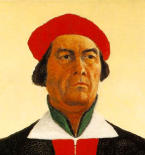Project 6 Photography versus painting
(Definition of resonance the effect of an event or work of art beyond its immediate or surface meaning)
After reading Brik’s article I think in the end both artists and photographers accepted that each interpreted a subject in his or her own way.
The case of photos versus painting is that photos give you instant results where as with the painting it takes time and if you wish to change the subject you simply take another photo where as with the painting you either change it or start again so photographs give you the quicker result.
Although there are artists who can and have produced paintings (some copies of masterpieces) in a matter of hours and are able to convince the art world that they are the originals? (I watched an interesting program on this subject on T.V.)
Painters thought that they could produce a painting in true colours with the use of various colours on the palette. This was not so in the early stages of photography, but as this progressed with trial and error when taking coloured photos they were able to show the true colours. As time has progressed coloured photograph can now be `doctored' to give a more realistic picture.
Painters then declared that ‘Precision is not the ultimate aim’ nature not being the subject more the initial idea on which to interpret in his or her own way.
i.e. the photographer captures life while the painter interprets it in his own way.
Some believe that art (painting, sculptures) is true art where as photographs are the insignificant art, the photographers dream is to produce photos that look more like paintings, by airbrushing etc?
R.M. Rodchenko Russian born 1891 died 1956 was once a painter, poster artist but changed to photography, which was mainly experimental so is not known to many people. He was a versatile Constructivist painter. Before turning to photo montage and photography he often shot photos from odd angles usually high or low to shock the viewer and postpone recognition he wrote “ one has to take several different shots of a subject as if one looks around instead of though the keyhole each time”
Rodchenko was at odds with Kasimir Malevich’s abstract spiritualism; this was shown in his transition towards constructivism when he argued his painting were “construction since they were made from real materials (canvas, wood, tacks, and pigment in oil)
Kasimir Malevich's painting
Self portrait
Rodchenko's paintings
Painting: White circle – 1918 oil on canvas in which he explored how different colours react in conjunction with different backgrounds and forms (an optical conflict occurs as the viewer’s eye tries to determine which of the two circles should hold precedence.
Rodchenko stopped photographing in the 1940s and returned to painting though he did continue to organise photography exhibitions for the Russian government during those years.
Rodchenko stopped photographing in the 1940s and returned to painting though he did continue to organise photography exhibitions for the Russian government during those years.
Photograph – White Sea Canal 1933 – built by criminals and other undesirables rehabilitated though labour. He took a number of photos that would provide the raw material for the masterpiece of political propaganda
One and three (Chairs) explores the nature of art rather than producing art pre se thus art is very self – referential to this art work features a physical chair a photograph of that chair and a text of a dictionary definition of a chair
The photo is a representation of the chair
The chair is a work of art
The definition is the photograph
Bruce Nauman born 1941 Indiana sculpture, photographs neon, video, drawing painting print and performance
Eating my words 1967 colour photograph
Transfers the artistic control from the act of creating to the act of reading the process that defines the work
Betty (1988) by Gerhard Richter born 1932 when I first looked at this picture I thought it must be a photograph the colours are so intense it is in fact a painting of a photograph (which is a technique used by Richter) this is of his daughter she faces away from us into to what looks like a black canvas but is in fact one of the artists dark abstract paintings. Betty seems to be unwilling to look at us and the black canvas is not likely to communicate with her so she is a a vold on her own so this presents a sense of absolute separation from everything and everyone. The darkness brings out the brightness of her colours notice too the hair which looks so real it gives the impression that you could reach out a touch her to make her turn. This thickly painted canvas evokes sadness and despair and was thought to be in response to the Vietnam war
The Stone Breakers 1849 by Gustave Courbet 1819-1877
oil on canvas
This depicts two labours breaking stone in a field of stark realism. The two men dressed in ragged clothes with their modest lunch pails in the background have their backs to the viewer (as did Betty) and are straining under the menial and demanding labour one to young for hard labour the other to old. This painting in my view is realistic to the point of being nearly a photograph as it is such a scene that you could imagine in life. Compared to (Betty) the colours are muted browns, yellows, orange and the rocks have a silvery sheen.








